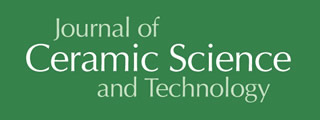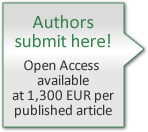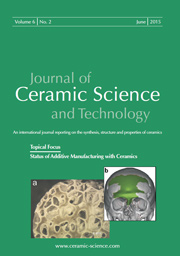Articles
All articles | Recent articles
Mechanical Characterisation of Carbon-Bonded Magnesia at Temperatures up to 1400 °C
J. Solarek1, C.G. Aneziris2, H. Biermann1
1 Institute of Materials Engineering, TU Bergakademie Freiberg, D-09599 Freiberg, Germany
2 Institute of Ceramic, Glass and Construction Materials, TU Bergakademie Freiberg, D-09599 Freiberg, Germany
received Febuary 12, 2016, received in revised form April 10, 2016, accepted April 15, 2016
Vol. 7, No. 2, Pages 193-202 DOI: 10.4416/JCST2016-00017
Abstract
The mechanical properties of carbon-bonded magnesia were investigated from room temperature to 1400 °C in tension, compression and bending. For this purpose, quasi-static, static and cyclic tests were conducted on two testing machines, equipped with inert atmosphere chambers and inductive heating devices. Characterisation of the microstructure was performed with scanning electron microscopy (SEM) and optical microscopy (OM). Porosity and density were measured with the Archimedes principle and pycnometry. From the creep tests, activation energies and Norton exponents for high-temperature creep deformation were determined. Additionally, scatter was addressed. The cyclic tests showed a high influence of stress amplitude on fatigue lifetime, whereas degradation of specimens only took place in tension.
![]() Download Full Article (PDF)
Download Full Article (PDF)
Keywords
Refractories, high temperature carbon-bonded magnesia, mechanical properties, creep
References
1 Ewais, E.M.M.: Carbon based refractories, J. Ceram. Soc. Jpn., 112, 517 – 532, (2004).
2 Jenkins, G.M: Analysis of the stress-strain relationships in reactor grade graphite, Br. J. Appl. Phys., 13, 30 – 32, (1962).
3 Seldin, E.J.: Stress-strain of polycrystalline graphites in tension and compression at room temperature, Carbon, 4, 177 – 191, (1966).
4 Fitchett, A.M., Wilshire, B.: Mechanical properties of carbon-bearing magnesia: parts I, II and III, Trans. J. Br. Ceram. Soc., 83, 54 – 76, (1984).
5 Allaire, C., Daillaire, S., Rigaud, M.: Creep behaviour of natural dolomite carbon-bonded magnesite bricks, J. Can. Ceram. Soc., 56, 45 – 48, (1987).
6 Ioka, I., Yoda, S., Konishi, T.: Acoustic emission for polycrystalline graphite under compressive loading, Carbon, 28, 489 – 495, (1990).
7 Franklin, S.A., Tucker, B.J.S.: Hot strength and thermal-shock resistance of magnesia-carbon refractories, Br. Ceram. Trans., 94, 151 – 156, (1995).
8 Robin, J.M., Berthaud, Y., Schmitt, N., Poirier, J., Themines, D.: Thermomechanical behaviour of magnesia-carbon refractories, Br. Ceram. Trans., 97, 1 – 11, (1998).
9 Schmitt, N., Berthaud, Y., Poirier, J.: Tensile behaviour of magnesia carbon refractories, J. Eur. Ceram. Soc., 20, 2239 – 2248, (2000).
10 Ouedraogo, E., Prompt, N.: High-temperature mechanical characterisation of an alumina refractory concrete for blast furnace main trough. J. Eur. Ceram. Soc., 28, 2867 – 2875, (2008).
11 Prompt, N., Ouedraogo, E.: High temperature mechanical characterisation of an alumina refractory concrete for blast furnace main trough, J. Eur. Ceram. Soc., 28, 2859 – 2865, (2008).
12 Briche, G., Tessier-Doyen, N., Huger, M., Chotard, T.: Investigation of the damage behaviour of refractory model materials at high temperature by combined pulse echography and acoustic emission techniques, J. Eur. Ceram. Soc., 28, 2835 – 2843, (2008).
13 Kakroudi, M.G., Yeugo-Fogaing, E., Huger, M., Gault, C., Chotard, T.: Influence of the thermal history on the mechanical properties of two alumina based castables, J. Eur. Ceram. Soc., 29, 3197 – 3204, (2009).
14 Werner, J., Aneziris, C.G., Dudczig, S.: Young's modulus of elasticity of carbon-bonded alumina materials up to 1450 °C, J. Am. Ceram. Soc., 96, 2958 – 2965, (2013).
15 Werner, J., Aneziris, C.G., Schafföner, S.: Influence of porosity on Young's modulus of carbon-bonded alumina from room temperature up to 1450 °C, Ceram. Int., 40, 14439 – 14445, (2014).
16 Solarek, J., Bachmann, C., Klemm, Y., Aneziris, C.G., Biermann, H.: Mechanical Characterisation of Carbon Bonded Alumina (Al2O3-C) at temperatures up to 1500 °C. In: Proceedings of the Unified International Technical Conference of Refractories. Vienna, Austria, September 15.-18. 2015
17 Solarek, J., Bachmann, C., Klemm, Y., Aneziris, C.G., Biermann, H.: High-temperature compression deformation behaviour of fine-grained carbon-bonded alumina, J. Am. Ceram. Soc., in press, (2016)
18 Solarek, J., Adlmaier, F.X., Aneziris, C.G., Biermann, H.: High Temperature Behaviour of Carbon Bonded Magnesia (MgO-C) at Temperatures up to 1500 °C. In: Proceedings of the Unified International Technical Conference of Refractories. Vienna, Austria, September 15.-18. 2015
19 Hino, Y., Yoshida, K., Kiyota, Y., Kuwayama, M.: Fracture mechanics investigation of MgO-C bricks for steelmaking by bending and fatigue failure tests along with x-ray CT scan observation, ISIJ Int., 53, 1392 – 1400, (2013).
20 Andreev, K., Boursin, M., Laurent, A., Zinngrebe, E., Put, P., Sinnema, S.: Compressive fatigue behaviour of refractories with carbonaceous binders, J. Eur. Ceram. Soc., 34, 523 – 531, (2014).
21 Hampel, M.: Contribution for the Characterization of Carbon Bonded Magnesia Refractories, in German, Dissertation at TU Bergakademie Freiberg, (2011).
22 Norm DIN EN 993: Methods of testing dense shaped refractory products – Part 8 and 9, (1997)
23 Solarek, J., Aneziris, C.G., Biermann, H.: Mechanical properties of carbon-bonded magnesia between room temperature and 1300 °C, in German, in DKG-Handbuch Technische Keramische Werkstoffe - Chap. 6.2.3.2, HvB Verlag, Ellerau, 2015
24 Funk, J.E., Dinger, D.R.: Derivation of the Dinger-Funk Particle Size Distribution Equation. In: Predictive Process Control of Crowded Particulate Suspensions, Springer US, Boston, MA, 1994.
25 Terzic, A., Pavlovic, Lj., Milutinovic-Nikolic, A.: Influence of the phase composition of refractory materials on creep, Sci. Sinter., 38, 255 – 263, (2006).
26 Rathner, R., Knauder, J.P., Schweiger, H.F.: Design aspects and thermomechanical behaviour of converter linings, in german, Radex-Rundschau, 45, 327 – 342, (1990).
27 Schacht, C.A.: Thermomechanical Behaviour of Refractories. Key Eng. Mat., 88, 193 – 218, (1993).
Copyright
Göller Verlag GmbH


